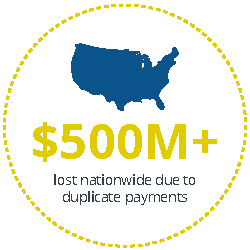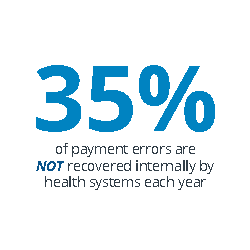Six Tips for Hospitals to Reduce Duplicate Payments
October 15, 2018
TAG Inc. to Present at the 2019 AHIA Annual Conference
June 19, 2019
Duplicate payments have been among one of the leading sources of leaking resources in healthcare systems for decades. Health systems in the United States lose over $500 million to duplicate payments annually. That’s right, duplicate payments are a half-billion-dollar per year mistake. Imagine what your healthcare organization could do if they saved those funds each year – update facilities, offer new services, treat more patients, upgrade to the latest technologies, or hire more resources.
It’s time for your organization to take a more proactive approach to mitigate the risks associated with “dupes” and save resources that directly affect your patient’s care.
Tips to Mitigate Duplicate Payment Risk in Healthcare
1. Monitor your Vendor Master for Accuracy
Checking your supplier list manually and regularly is essential to preventing duplicate suppliers in your ERP, which puts your organization at risk for multiple payments.
Duplicate suppliers are often entered into an organizations’ ERP system when the suppliers are inadvertently defined by different names.
Examples of common mistakes:
- Abbreviation: Corp vs Corporation
- Using Acronyms: NYC vs New York City
- Parent/Child Relationships: GE Health vs GE Medical
- Punctuation: “TAG, Inc.” vs “TAG Inc”
In the past year, 25% of all duplicate payments made by TAG clients were the result of duplicate suppliers.
TAG TIP: We recommend reviewing your vendor master files once a quarter at a minimum. Remove duplicate suppliers and inactive suppliers from your ERP system.

2. Utilize one method for receiving invoices
From mail, email, and fax, vendors have their own preferred method of invoicing, which can leave your organization paying for the same supplies multiple times. Put a vendor policy in place limiting your vendors submitting invoices through one method. With only one inbound channel to monitor, the risk for duplicate payments reduces significantly.
TAG TIP: Have all invoices sent to a central location controlled by your accounts payable team rather than different departments throughout your hospital(s).
3. Limit yourself to only one ERP system
If you use multiple ERP platforms across your healthcare organization, you are not alone. Eliminating multiple systems is crucial to mitigate risks of the same invoices being paid in each system, but we realize this is not always practical. Streamlining your operation to use one ERP, eliminates this risk altogether – if your organization is in a position to make such a substantial change.
TAG TIP: If you are not ready to consolidate ERP systems, create a monthly payments report to compare both scheduled and completed payments in each system to ensure duplicates were not made.
4. Create consistent data entry standards
It is essential to create a set of rules for data entry specific to invoicing and payments. Ensure consistency is maintained when creating POs and entering vendor information.
When creating your data entry standards consider the following:
- Leading zeros
- Spaces
- Dashes
- Special characters
- Capitalization of alpha-numeric characters
TAG TIP: Implement “refresher” training for your data entry staff. Consistently training your employees reinforces fundamental practices and increases the self-confidence and morale of your team, meaning higher productivity and fewer mistakes.
5. Use technology to reduce human error
While human error cannot be entirely prevented, measures can be taken to reduce this type of risk. Human error often occurs during pivotal data input such as vendor, invoice, or purchase order (PO) numbers.
Software equipped with optical character recognition (OCR) can help reduce human error. This technology scans documents and captures their data to automatically input into your ERP system. However, organizations should not rely solely on OCR as computers can often mistake similar characters. Common errors are mistaking a “5” for an “S” or a lowercase “L” for a “1.” Therefore, it is essential that technology and the human eye verify data entry to reduce the risk of duplicate payments.
Of all duplicate payments recovered by TAG in the past year, 49% were based on data input errors.
TAG TIP: Create a checklist listing all information your data entry team must review before submitting an invoice into your system. Place this checklist in full view of all employees involved.

 Internal departments in the healthcare industry do a remarkable job by recovering most of all payment errors … however, they only recover, on average, about 65% of all payment errors. That leaves another 35% at risk; a number costing organizations millions each year. Stop your system from leaking funds and start taking action to reduce duplicate payments today.
Internal departments in the healthcare industry do a remarkable job by recovering most of all payment errors … however, they only recover, on average, about 65% of all payment errors. That leaves another 35% at risk; a number costing organizations millions each year. Stop your system from leaking funds and start taking action to reduce duplicate payments today.
Need help recovering that extra 35%? Looking for long-term solutions to prevent payment errors? That’s why we’re here. TAG specializes in the process improvement of healthcare systems’ supply chain and financial workflow. Learn more about how we can help recover your resources, discover root causes, and optimize your processes, by contacting us today.


